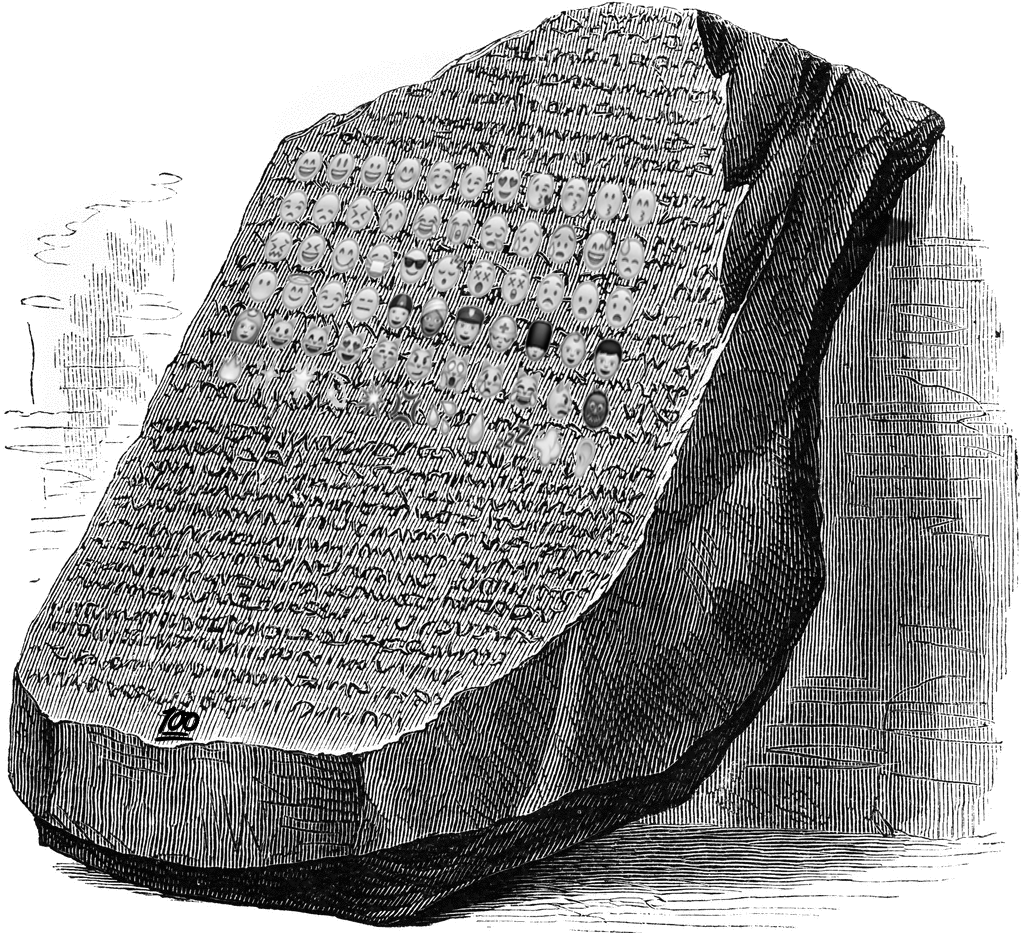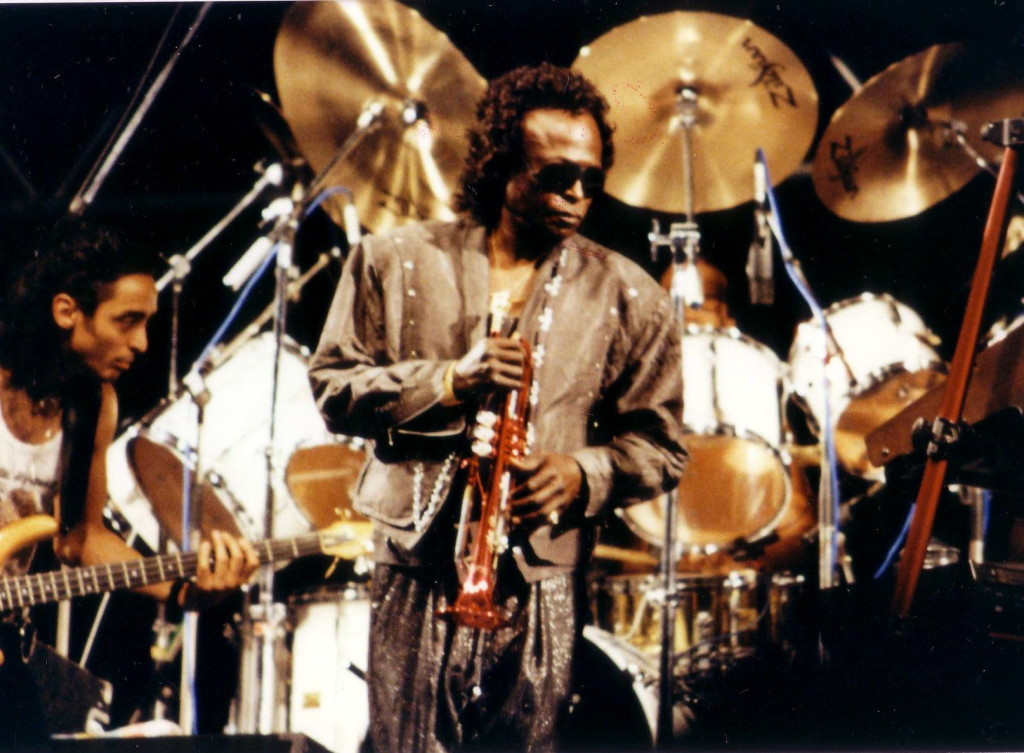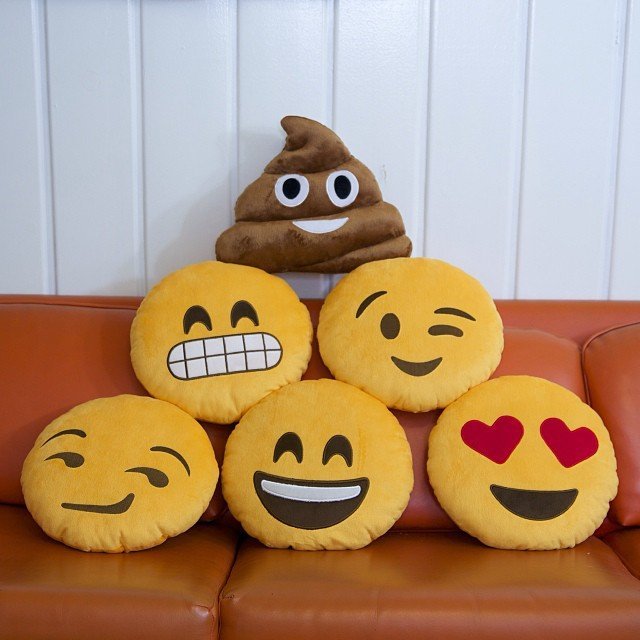A number, a word or a concept? The 💯 emoji taken at face value may simply be an oddly formatted version of a number, a wayward wingding of indeterminate use. But to members of certain segments of Twitter (often broadly referred to as “Black Twitter), 💯 symbolizes a great deal more. There, it indicates authenticity, a very Black in-reference to the phrase “keeping it 100.” It is generally used and understood as such among these circles, and has been exported into popular culture through media like Larry Wilmore’s Nightly Show. 💯 has gone from a funny text picture to a form representing greater ideas not otherwise translatable so succinctly. Consequently, this emoji and many others, have become greater than the images they were originally intended or understood to represent. They have, quite literally, become iconic.
Are emoji a new and budding form of online language? It might depend on who you ask. These little pictographs have developed a vast range of contextual meanings among certain circles, but by design very few of them have become universal. For some, an 🍆 is just an 🍆. For many Instagram users, it’s a dick, and has been banned along with other suggestive phrases in Instagram searches. Emoji occupy a special place in the vernacular of Black Twitter, and perhaps their increased contextualization has something to do with the structure and form of linguistic characteristics of minority groups online.
A look back at the history of emoji is instructive in understanding their place in Black Twitter. Of course, the concept of pictographs dates about as far back as humanity itself, with painted symbols of objects becoming the first form of non-verbal, non-sign language communication. As systems evolved and some of these symbols gained meaning beyond the actual objects they represented, they became ideographs instead of pictographs, and what linguists call “proto-language” was invented.
Fast-forward a few thousand years and pictographs have made a remarkable comeback in world culture, used in ways none-too-different than their Neolithic ancestors. The predecessors of emoji are emoticons, developed from various budding ways to indicate emotion in text. Perhaps the earliest usage of a proto-emoticon was in the transcript of an Abraham Lincoln speech in 1862, but other examples abound through written history. In the early 1980s Scott Fahlman, a computer scientist at Carnegie Mellon University, formalized and codified smileys for use in Carnegie Mellon message boards. The smiley–the emoticon–as a major digital supplement to text was born.
Variants of the emoticon became hits in the budding Japanese mobile markets in the mid to late 90s. Kaomoji followed emoticons, and they were developed into a massive library of artistic punctuation-based expressions. Japan, with its high degree of connectivity, mobile communications via two-way pagers, and high cultural context, was a natural innovation lab for the rapid development of these kaomoji into something more. Kanji-a form of writing that still incorporates pictographic and ideographic elements-considered the early building blocks that led from images to words, was the early facilitator for this transition. Kanji, kaomoji, and the popularity of pictographs in wider Japanese society set the stage for a revolution.
Shigetaka Kurita was the person who set the wheels into motion. A programmer working on the earliest mobile internet platforms in Japan, he wanted to find a way to express simple ideas and concepts, like weather, in ways that both fit the physical screen and fit the pictographic persuasion of Japanese media. He used the pictographic and ideographic origins of kaomoji and kanji to create symbols that at their inception were designed to fill in the space between basic picture representations of objects (pictographs) to symbolic representations of ideas and concepts that weren’t word units (ideographs). Kurita drew the symbols by hand, taking stylistic cues from anime and manga style art and deriving meaning from existing kanji and kaomoji puns.
Thus, emoji were given form. They flourished in Japan for almost a decade until they were brought over to the United States by an obscure feature in an iPhone operating system. Shortly after, they were adopted in Unicode, a universal encoding standard for displaying text and fonts across different languages and regions. Emoji spread to the United States and abroad as quickly as phones could be updated.
How did these symbols obtain special status in Black Twitter? African-American usage of the English language has a special structure that makes the most out of emoji. Call it African-American Vernacular English, AAVE, Black English, or Ebonics; the history is just as complex and rich either way. AAVE is the end result of a base stock of West African language structures and early Southern English sent through the blender of Black ingenuity. Grammatical rules are surprisingly constant, although they often resemble structures of languages other than English (“I ain’t got no quarters,” is basically French. Stick your pinky up).
However, vocabulary in AAVE shifts like quicksand and context becomes key in parsing meaning. This is important for AAVE, as it belongs to a high context culture, or one in which “[w]ords are not so important as context, which might include the speaker’s tone of voice, facial expression, gestures, posture—and even the person’s family history and status.” Many communities of color exist as high-context cultures, which stand at odds with America’s generally low-context culture.
Thus, for Black Americans, creating ciphers of deep layers of context has always been a smokescreen for both avoiding cultural appropriation and for staying a step ahead of oppressors. Ebonics is jazz, and jazz quickly becomes exported to the mainstream. As Dr. Jonathan Rosa, an expert in anthropology and linguistics and associate professor at UMass Amherst describes, “We’ve seen a history of racialized populations performing semantic inversion on different forms or creatively constructing new sorts of meaning and new forms that then get appropriated by mainstream populations.”
This jazz, when exported via Black Twitter, has become the object of American mainstream fascination, shifting between voyeurism, genuine appreciation, envy, and appropriation. There are Black Twitter beats and dozens of reactions to it. These are all, in a way, manifestations of the fascinations with our jazz. When the New York Times describes the “unabashedly black spin on life,” that’s a description of jazz. And when emoji met Black Twitter, jazz met Japanese culture, an interaction that has often borne interesting fruit. The high-context usage of emoji in Japan thrived in the high-context nature of Black Twitter. Black Twitter and other online communities of color adopted emoji quickly, and in doing so connected themselves with an age-old tradition of multi-layered pictographs, even stretching back to and through Egyptian hieroglyphics.
But even though Black Twitter and other communities of color have a unique recent history with emoji, does this usage qualify as something beyond just a notable quirk? Dr. Rosa discussed how emoji’s potential as language rested on their usage. “Are emoji becoming a language?” Rosa asked. “When you ask about POC specifically, then it becomes interesting. Do people in different groups use emoji in different ways?” The key to forms being recognized as distinct languages involves creation of distinct meanings specific to the speaking group and unambiguously recognized within it.
Emoji enthusiast and expert Jenna Wortham, a staff writer for the New York Times Magazine, gave some indications that those kinds of differentiation may already be happening in her circles. “I feel like if I were a child of parents that didn’t speak English, emoji would be like going back to my own language,” states Wortham. “Going back and forth between something that feels really more like familiarity…there’s an element of comfort, [I’m] less worried about being misinterpreted. Less worry about being considered flippant.” This experience, of adopting a usage within and without certain contexts is strikingly similar to code switching, an experience common to users of non-standard dialects and second languages.
Wortham also speaks to some unique usages of emoji in Black Twitter and in her experience. “One thing about Twitter is the default association we have it’s really hard to imagine other folks using it a different way. For me the all teeth emoji is a grimace and outside of that frame there’s people that see it as a smile.” There are other examples as well. “I actually have a t-shirt with 💯 on it. I won’t even wear it because I don’t want to mess it up. The 💯 is the best one. It was the blackest emoji we had before there were black emojis. It was like coolness. We have the different skin tone emojis now but you have to find the ones that have your context and the 💯 already has it. That’s my favorite emoji.”
Of course there are a library of other emoji with broadly understood additional meanings in Black Twitter.🐸 ☕️ would appear to be a non-sequitur, but it’s really just someone minding their own damn business, often sarcastically. 🍑 is just a peach, but given its vague similarity to a butt and the peach’s already semi-sexual connotation in urban music, in some cases it becomes almost as sexual as the eggplant. The new moon is just a new moon, until it’s 🌚,and then it can mean shyness or shadiness. Even basic smileys have different meanings, as referenced by Wortham.
Of course, a body of emoji with specific meanings in a subculture does not a language make. These things are the beginnings, the strands of a scaffold for building additional language conventions on. And they operate in this case through AAVE, which itself enjoys a murky status somewhere between dialect, pidgin, and distinct language, depending on who’s doing the defining. Even formal definitions of language are tricky. Dr. Rosa explains:
“What’s difficult is to compare to something that comes to be considered a ‘full language,’ but there’s no such thing as a ‘full language.’ Based on what definition? Even linguists and linguistic anthropologists for example disagree on what a language is. For linguists, the way you study language is by looking at syntax, morphology, these different structural properties of communication, whereas for anthropologists you study interactions. You study ideology, you study context. So there’s no set sort of definition of exactly what a language is, and there are other purely written languages. Any coding language is a constructed, purely written language. So, the question then is ‘are those full languages?’”
The comparison with coding languages is apt, since emoji and code are both constructed and purely digital systems. The main difference between emoji and code (in the sense that emoji are in any way distinct) is that, as detailed here, emoji accrue meaning and context in a way similar to natural languages, while code adheres to a rigid structure of original intent assigned by its creators.
Emoji share one more similarity with our constructed languages: that new forms are added by a person or group of people that have power over it. While innovation and assigning new meaning to the pictographs in communities of color increase their richness tenfold, neither you nor I could decide tomorrow that we could use an extra emoji for a phallic food. There’s an interesting, perhaps troubling, power dynamic at play, especially given AAVE’s history of fluidity as rebellion. As Dr. Rosa details: “Is the general population endowed with the capacity to create new emoji? And I think you see people requesting things, but they roll out at the behest of designers. And then the question is : who are those designers? What demographics do they represent? And to what demographics do they respond?”
Just days after the NBA emoji war and World Emoji Day and just days before a whole new selection of emoji are rolled out, these questions are important. Emoji are just getting started as a means of communication, and they’ve already gained special status in communities of color. Studying how they develop as some quasi-proto-language along an anthropological linguistic continuum is vital in understanding something peculiar: a digitally created code system that picks up context and new connotations like real languages. This study also helps understand our own existing language structures; dialects and first languages in communities of color.
But for the basic question, are they trending towards becoming a proto-language? According to Dr. Rosa, “you could certainly stake a claim to that.” To Jenna Wortham, the distinction matters less than how much emoji have enriched the way we communicate:
“It’s just hard to have this much fun with traditional language.”




